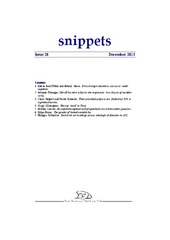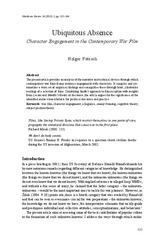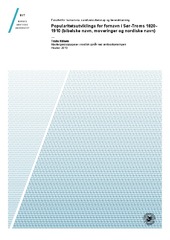Institutt for språk og kultur: Nye registreringer
Viser treff 1721-1740 av 2199
-
Not all locative subjects are arguments: two classes of weather verbs
(Journal article; Tidsskriftartikkel; Peer reviewed, 2013) -
Differential Object Marking in Spanish: state of the art
(Journal article; Tidsskriftartikkel; Peer reviewed, 2013)This state-of-the-art review tries to cover as much as possible about the properties, conditions and analyses of Differential Object Marking (DOM) in Spanish. Starting with some considerations about the boundaries of the phenomenon, it considers its morphological, semantic and syntactic properties –with respect both to the internal properties of the direct object and to the wider context in which ... -
Ubiquitous absent enemies: character engagement in the contemporary war film
(Journal article; Tidsskriftartikkel; Peer reviewed, 2013)The present article provides an analysis of the narrative and technical devices through which contemporary war films frame audience engagement with characters. It compiles and systematizes a wide set of empirical findings and exemplifies these through brief, illustrative readings of a selection of films. Combining Smith’s approach to film reception with insights from Laclau and Mouffe’s theory of ... -
Pristavki v svete kognitivnoj lingvistiki i tipologii: otklik na stat’ju A.A. Zaliznjak i I.L. Mikaèljan
(Journal article; Tidsskriftartikkel; Peer reviewed, 2013)В статье [Янда 2012] предлагается рассматривать глагольные приставки в русском языке как систему с глагольными классификаторами. В ответной статье [Зализняк, Микаэлян 2012] крити- куется подход, теория когнитивной лингвистики, в рамках которой было высказано предположе- ние, и данные, на основе которых были сделаны выводы. В следующем отклике рассматривается одно из важных отличий теории когнитивной ... -
Ingredienser for forskningsledelse: konkrete prosjekter, intern fagfellevurdering, effektive møter, gruppetilhørighet
(Conference object; Konferansebidrag, 2013) -
Time and space in parallel streams: in place of an introduction
(Journal article; Tidsskriftartikkel; Peer reviewed, 2013)We are pleased to present Space and Time in Russian Temporal Expressions as a special issue of Russian Linguistics, guest edited by Laura A. Janda, Stephen M. Dickey, and Tore Nesset. Here we offer some of the research results of the CLEAR (Cognitive Linguistics: Empirical Approaches to Russian) group1 at the University of Tromsø and our collaborators. This research was sponsored by a grant from the ... -
Popularitetsutviklinga for fornavn i Sør-Troms 1820-1910 (bibelske navn, moveringer og nordiske navn)
(Master thesis; Mastergradsoppgave, 2013-10-31)I denne avhandlinga har jeg undersøkt popularitetsutviklinga for fornavn i Sør-Troms i perioden 1820-1910. Fokuset har jeg lagt på de tre mest interessante navnekategoriene som en kan finne i denne perioden: de bibelske navnene, moveringene og de nordiske navnene. Undersøkelsen er basert på folketellingene i 1865, 1900 og 1910, og jeg undersøker både kvinnenavn og mannsnavn. De bibelske fornavnene ... -
Aspectos de sociolingüística del español de Cádiz: formas de tratamiento y actitudes lingüísticas
(Master thesis; Mastergradsoppgave, 2013-11-01)The aim of this thesis is to provide a study of sociolinguistic aspects of the Spanish variety spoken in Cádiz, city in the province with the same name, located in Andalucía. The focus will be on the following subjects: the linguistic attitudes of the community in Cádiz towards their own speech and the use of the address forms in the same city, concentrating on the young generation. Here, the main ... -
Kola Sami language revitalisation - opportunities and challenges.
(Chapter; Bokkapittel, 2013)Today, all four Kola Sami languages are seriously endangered by a language shift from Sami to Russian. However, a language revitalisation process has started. Particularly the Kildin Sami language community in Lovozero seems to have the necessary political, financial and practical conditions for being able to carry out an effective language revitalisation, also in terms of a reintroduction of ... -
Non-concatenative morphology as epiphenomenon
(Chapter; Bokkapittel, 2011)Non-concatenative morphological phenomena appear on the face of it to require a powerful morphological component, capable of more than straightforward addition of affixes consisting of segmental material. The chapter proposes that the full range of non-concatenative phenomena may be completely accounted for in piece-based terms using analytical tools that are independently necessary. These phenomena ... -
Quantitative Methods in Cognitive Linguistics
(Chapter; Bokkapittel, 2013)Designed to serve as a textbook for courses in statistical analysis in linguistics, this book orients the reader to various quantitative methods and explains their implications for the field. The methods include chi-square, Fisher test, binomial test, ANOVA, correlation, regression, and cluster analysis. The advantages and limitations of each method are detailed and each method is illustrated with ... -
Russian ‘purely aspectual’ prefixes: Not so ‘empty’ after all?
(Journal article; Tidsskriftartikkel; Peer reviewed, 2012)Nearly two thousand perfective verbs in Russian are formed via the addition of so-called “empty prefixes” (čistovidovye pristavki) to imperfective base verbs. The traditional assumption that prefixes are semantically “empty” when used to form aspectual pairs is problematic because the same prefixes are clearly “non-empty” when combined with other base verbs. Though some scholars have suspected that ... -
Verbal Prefixation and Metaphor: How Does Metaphor Interact with Constructions?
(Journal article; Tidsskriftartikkel; Peer reviewed, 2013)This article argues that metaphorical and non-metaphorical content find different expression on the constructional level. The hypothesis is supported by two empirical case studies of the Russian Locative Alternation verbs, based on the data from the Russian National Corpus: the unprefixed verb sypat’ ‘strew’ (which does not have an aspectual partner) and the unprefixed verb gruzit’ ‘load’ and its ... -
Nouns or verbs? A case study of the Russian words bain’ki, kušan’ki, spaten’ki and gulen’ki
(Journal article; Tidsskriftartikkel; Peer reviewed, 2012)In this article I investigate part of speech distinctions in Russian based on an in-depth analysis of an understudied group of words, namely bain’ki ‘sleep’, spaten’ki ‘sleep’, kušan’ki ‘eat’ and gulen’ki ‘walk’, which are mainly used in speech with or about children, but which regardless of their high frequency and productivity remain ignored in Russian linguistics. The main question is: what part ... -
A cue-based approach to the acquisition of grammatical gender in Russian
(Journal article; Tidsskriftartikkel; Peer reviewed, 2012)This article discusses the acquisition of gender in Russian, focusing on some exceptional subclasses of nouns that display a mismatch between semantics and morphology. Experimental results from twenty-five Russian-speaking monolinguals (age 2;6–4;0) are presented and, within a cue-based approach to language acquisition, we argue that children rely on certain morphosyntactic micro-cues in the course ... -
Tospråklighet og ordstilling i norske possessivkonstruksjoner
(Journal article; Tidsskriftartikkel; Peer reviewed, 2012)I norske eiendomskonstruksjoner kan possessiven enten stå foran eller etter substantivet. Når enspråklige norske barn tilegner seg disse strukturene, foretrekker de først den foranstilte possessiven, selv om denne er mye mindre frekvent enn den etterstilte. Dette skyldes trolig at postnominale possessiver er strukturelt mer komplekse enn prenominale. I denne artikkelen undersøker vi denne ... -
How ‘here’ and ‘now’ in Russian and English establish joint attention in TV news broadcasts
(Journal article; Tidsskriftartikkel; Peer reviewed, 2013)This article presents a thorough investigation of the five Russian deictic words that correspond to the English meanings ‘here’ and ‘now’: zdes’, tut, sejčas, teper’ and vot. We analyze data from the Russian National Corpus and data from Russian TV news broadcasts. On the basis of the corpus data, we propose a radial category network consisting of nine subcategories, which encompass all five words, ... -
Самостоятельные морфемы или позиционные варианты? Морфологический статус русских приставок о- и об- в свете новых данных: корпус и эксперимент.
(Journal article; Tidsskriftartikkel; Peer reviewed, 2013)This article examines an interesting phenomenon in Russian morphology: the behavior of the prefixes o- and ob-. Do these prefixes constitute two distinct morphemes or are they allomorphs of a single morpheme? Previous discussion in scholarly works has been limited to lexical data provided in dictionaries. A number of controversial uses of these prefixes were discovered and led to the hypothesis ... -
Space-time asymmetries: Russian v ‘in(to)’ and the North Slavic Temporal Adverbial Continuum
(Journal article; Tidsskriftartikkel; Peer reviewed, 2013)This article presents a corpus-based investigation of temporal adverbials with special focus on Russian в ‘in(to)’ and its cognates in North Slavic (Belarusian, Ukrainian, Polish and Czech). We advance the Constraint Hypothesis, according to which case government is more restricted in the domain of time than in the domain of space. This hypothesis receives support from the five languages under ... -
English as a Mixed V2 Grammar: Synchronic Word Order Inconsistencies from the Perspective of First Language Acquisition
(Journal article; Tidsskriftartikkel; Peer reviewed, 2007)This paper discusses some word order inconsistencies found in present-day English and argues that these may be explained by natural processes in first language acquisition. English is usually assumed to have lost its verb-second (V2) properties in the Middle English period, but the paper argues that English should be considered a mixed V2 grammar, as subject-auxiliary inversion is still a syntactic ...


 English
English norsk
norsk


















